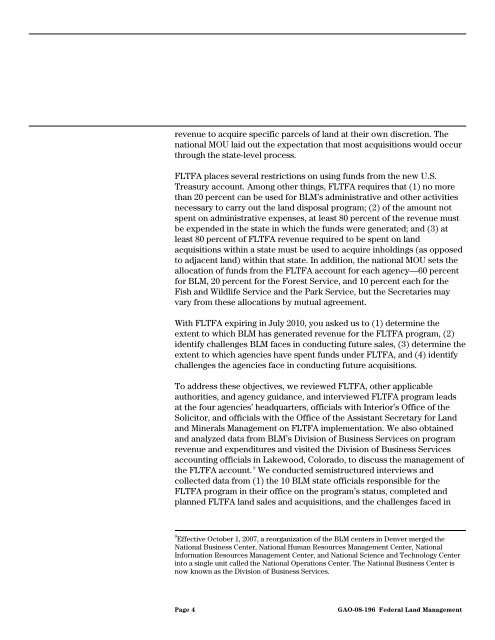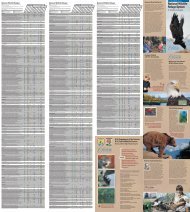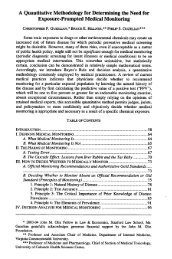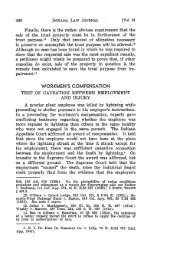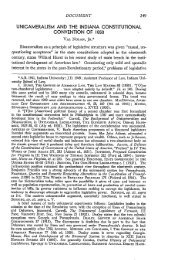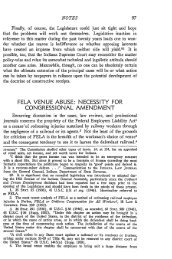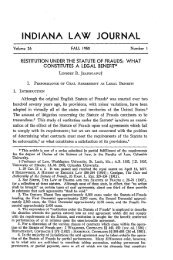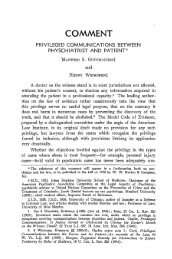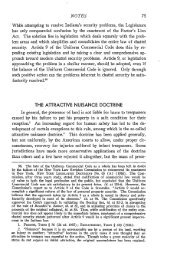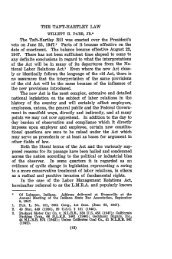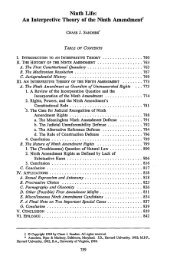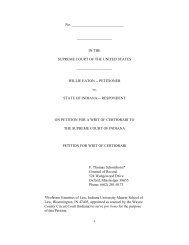Federal Land Transaction Facilitation Act Restrictions and ...
Federal Land Transaction Facilitation Act Restrictions and ...
Federal Land Transaction Facilitation Act Restrictions and ...
Create successful ePaper yourself
Turn your PDF publications into a flip-book with our unique Google optimized e-Paper software.
evenue to acquire specific parcels of l<strong>and</strong> at their own discretion. The<br />
national MOU laid out the expectation that most acquisitions would occur<br />
through the state-level process.<br />
FLTFA places several restrictions on using funds from the new U.S.<br />
Treasury account. Among other things, FLTFA requires that (1) no more<br />
than 20 percent can be used for BLM’s administrative <strong>and</strong> other activities<br />
necessary to carry out the l<strong>and</strong> disposal program; (2) of the amount not<br />
spent on administrative expenses, at least 80 percent of the revenue must<br />
be expended in the state in which the funds were generated; <strong>and</strong> (3) at<br />
least 80 percent of FLTFA revenue required to be spent on l<strong>and</strong><br />
acquisitions within a state must be used to acquire inholdings (as opposed<br />
to adjacent l<strong>and</strong>) within that state. In addition, the national MOU sets the<br />
allocation of funds from the FLTFA account for each agency—60 percent<br />
for BLM, 20 percent for the Forest Service, <strong>and</strong> 10 percent each for the<br />
Fish <strong>and</strong> Wildlife Service <strong>and</strong> the Park Service, but the Secretaries may<br />
vary from these allocations by mutual agreement.<br />
With FLTFA expiring in July 2010, you asked us to (1) determine the<br />
extent to which BLM has generated revenue for the FLTFA program, (2)<br />
identify challenges BLM faces in conducting future sales, (3) determine the<br />
extent to which agencies have spent funds under FLTFA, <strong>and</strong> (4) identify<br />
challenges the agencies face in conducting future acquisitions.<br />
To address these objectives, we reviewed FLTFA, other applicable<br />
authorities, <strong>and</strong> agency guidance, <strong>and</strong> interviewed FLTFA program leads<br />
at the four agencies’ headquarters, officials with Interior’s Office of the<br />
Solicitor, <strong>and</strong> officials with the Office of the Assistant Secretary for <strong>L<strong>and</strong></strong><br />
<strong>and</strong> Minerals Management on FLTFA implementation. We also obtained<br />
<strong>and</strong> analyzed data from BLM’s Division of Business Services on program<br />
revenue <strong>and</strong> expenditures <strong>and</strong> visited the Division of Business Services<br />
accounting officials in Lakewood, Colorado, to discuss the management of<br />
the FLTFA account. 9 We conducted semistructured interviews <strong>and</strong><br />
collected data from (1) the 10 BLM state officials responsible for the<br />
FLTFA program in their office on the program’s status, completed <strong>and</strong><br />
planned FLTFA l<strong>and</strong> sales <strong>and</strong> acquisitions, <strong>and</strong> the challenges faced in<br />
9 Effective October 1, 2007, a reorganization of the BLM centers in Denver merged the<br />
National Business Center, National Human Resources Management Center, National<br />
Information Resources Management Center, <strong>and</strong> National Science <strong>and</strong> Technology Center<br />
into a single unit called the National Operations Center. The National Business Center is<br />
now known as the Division of Business Services.<br />
Page 4 GAO-08-196 <strong>Federal</strong> <strong>L<strong>and</strong></strong> Management


